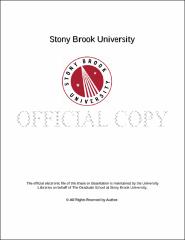| dc.identifier.uri | http://hdl.handle.net/11401/76678 | |
| dc.description.sponsorship | This work is sponsored by the Stony Brook University Graduate School in compliance with the requirements for completion of degree. | en_US |
| dc.format | Monograph | |
| dc.format.medium | Electronic Resource | en_US |
| dc.language.iso | en_US | |
| dc.publisher | The Graduate School, Stony Brook University: Stony Brook, NY. | |
| dc.type | Dissertation | |
| dcterms.abstract | With recent advances in phase imaging techniques and the development of new, novel specimen holders in which a variety of stimuli can be applied to magnetic samples in situ, the transmission electron microscope (TEM) has become a useful tool in studying the properties of magnetic materials at nanoscale. The resolution afforded by electron microscopy techniques allows for subtle changes to spin textures to be observed. Here, work on understanding the dynamic motion of spin-torque and magnetic field driven resonant vortex motion is presented, as well as experiments in regards to the role of defects in the ordering processes of artificial spin ices. First, the role that defects and charge ordering play in the ordering processes in artificial spin ice lattices will be discussed. Experimentally, we find that reversal along the (11) symmetry axis results in local ground state ordering but long range frustration. Furthermore, defect interactions ultimately limit their maximum density within the lattice. Next, while essential to understanding current driven domain wall motion, non-adiabatic spin-torque effects are poorly understood. In spin-torque driven magnetic vortices, subtle changes to the magnitude of the resonant orbits with varying chirality allow for the separation of adiabatic, non-adiabatic, and Oersted field contributions to the motion, as well as for the direct measurement of the non-adiabatic parameter with the greatest precision to date. Off-resonance effects are also probed for the first time. Additionally, despite field-driven dynamics of single vortices near equilibrium being well understood, far-from-equilibrium and coupled dynamics are significantly more complex, and due to experimental constraints, poorly understood. The dynamic response in both interlayer exchange coupled vortices in a stack geometry and direct exchange coupled vortices in a lateral geometry will be explored, and far-from-equilibrium results will be presented. | |
| dcterms.available | 2017-09-20T16:50:57Z | |
| dcterms.contributor | Dawber, Matthew | en_US |
| dcterms.contributor | Zhu, Yimei | en_US |
| dcterms.contributor | Calder, Alan | en_US |
| dcterms.contributor | Vescovo, Elio. | en_US |
| dcterms.creator | Pollard, Shawn | |
| dcterms.dateAccepted | 2017-09-20T16:50:57Z | |
| dcterms.dateSubmitted | 2017-09-20T16:50:57Z | |
| dcterms.description | Department of Physics. | en_US |
| dcterms.extent | 122 pg. | en_US |
| dcterms.format | Application/PDF | en_US |
| dcterms.format | Monograph | |
| dcterms.identifier | http://hdl.handle.net/11401/76678 | |
| dcterms.issued | 2015-05-01 | |
| dcterms.language | en_US | |
| dcterms.provenance | Made available in DSpace on 2017-09-20T16:50:57Z (GMT). No. of bitstreams: 1
Pollard_grad.sunysb_0771E_12400.pdf: 3400733 bytes, checksum: 755cc3039ef993645f577c590da9ec80 (MD5)
Previous issue date: 2015 | en |
| dcterms.publisher | The Graduate School, Stony Brook University: Stony Brook, NY. | |
| dcterms.subject | Magnetism, Nanomagnetism, Spin Ice, Spin torque, Spintronics, Transmission Electron Microscopy | |
| dcterms.subject | Condensed matter physics | |
| dcterms.title | Probing Topological Magnetism with Transmission Electron Microscopy | |
| dcterms.type | Dissertation | |

